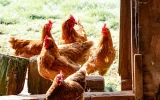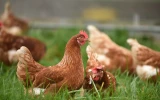How Many Animals To Be a Farm for Tax Purposes? (Not Many)
If you are considering establishing a farm for tax purposes, you may be wondering how many animals you need to qualify. The answer may surprise you: it takes very few animals to qualify as a farm for tax purposes. In this article, we will discuss the criteria and the number of animals you need to meet the requirements of a farm for tax purposes.
Generally, having two or more animals that are used to produce a farm product is enough to be considered a farm for tax filing purposes. This could include cows, horses, goats, sheep, llamas, alpacas, and other animals that can be used to produce things like meat, dairy, eggs, and other farm products.
In some cases, you may even be eligible for tax credits or deductions if you have a certain number of animals. Know about the rules and regulations in these certain applications in a legal aspect.
Summary
- For tax purposes, you don't need many animals to qualify as a farm.
- The number of animals required to qualify as a farm is surprisingly low, with only a few animals required in many cases.
- The Internal Revenue Service (IRS) has certain requirements for what constitutes a farm for tax purposes.

On this page:
You Need at Least Two Animals to Be Considered a Farm for Tax Purposes
Having two or more animals that are used to produce a farm product is enough to be considered a farm for tax filing purposes. To be considered a farm for tax filing purposes, the animals must be used for commercial or subsistence farming. This means that the animals must be used to produce a farm product such as milk, eggs, meat, honey, wool, or fur.
Additionally, two or more animals of the same species must be present and actively used in the production of the farm product. The farm animals must be owned by and maintained by the taxpayer, and the farm product must be produced in a sufficient quantity to be sold or used for subsistence purposes.
If the animals are used in the production of farm products that are not intended for sale, such as horses used for recreational riding, this will not qualify as a farm for tax filing purposes.
Tax Requirements to Qualify for Farm Status
Under the Internal Revenue Service (IRS) regulations, the following requirements must be met to qualify for farm status:
- Animals must be held for use in a farming business, such as for breeding, dairy, raising, or production of agricultural products.
- The animals must be kept for a significant portion of the year.
- A farm must show a profit for three out of five years to qualify as a farm for tax purposes.
- The animals must be managed in a way that is consistent with good farming practices.
- The owner must be actively involved in the farming business and make a significant contribution to the success of the business.
- The animals must be kept in a manner that is consistent with the general health of the animals. The animals must be cared for humanely.
- The animals must be kept in a safe and secure environment.
Six Types of Animals Produce a Farm Product
These are the few animals that are included to produce a farm product that is enough to be considered a farm for tax filing purposes.
1. The use of cows to produce a farm product is sufficient to qualify as a farm for tax purposes
A minimum of five cows must be kept in a pasture with adequate grazing and water supply. The farm must be kept up to the standards of the local agricultural authority. Cows must be of the age and breed to be used for dairy or meat production and must be well cared for, with a regular schedule of vaccinations, worming, and hoof trimming.
The farm must have a milking facility, such as a dairy barn, with milking equipment and storage tanks. The farm must have a plan for disposing of manure and must keep records of animal health, production, and sales.
2. The use of horses in the production of farm products is enough to qualify a farm for tax purposes
The employment of horses in the production of a farm product is enough to qualify as a farm for tax purposes. This includes the use of horses to plow fields, cultivate the soil, and pull implements. Other activities such as haymaking and manure management may also be included.
Horses can be used to transport farm products, such as hay bales, to market. Finally, horses can be used to provide recreational activities, such as trail rides, that may generate income for the farm.

3. The use of goats in the production of a farm product qualifies as a farm for tax purposes
The use of goats in the production of a farm product qualifies as a farm for tax purposes if the goats are used in an activity that is considered agricultural or horticultural. This includes activities such as grazing, milking, breeding, and producing wool, meat, or dairy products. The goats must also be used in a manner that is consistent with the customary practices of the particular agricultural or horticultural industry.
Additionally, the use of goats in the production of a farm product must be done to make a profit. If these criteria are met, then the use of goats in the production of a farm product can be considered a farm for tax purposes.
4. The use of sheep in the production of a farm product counts as a farm for tax purposes
To be eligible for tax purposes, the sheep must be used in the production of a farm product such as meat, wool, hides, or milk. The sheep must be kept, bred, and managed by the farmer to produce the farm product.
The sheep must also be used in the production of the farm product regularly and not just for occasional uses such as show animals or hobby animals. The farmer must also be able to demonstrate that the sheep are used for the production of the farm product and not just for recreational purposes. The farmer must also keep records of the costs associated with the production of the farm product such as feed and veterinary care.

5. Llamas used in the production of a farm product count as a farm for tax purposes
Llamas used in the production of farm products can be counted as a farm for tax purposes if certain criteria are met. These criteria include:
- having a primary purpose of agricultural production,
- engaging in agricultural production activities continuously and regularly, and;
- producing a product that is normally produced by a farm
Additionally, the llamas must be used in a way that contributes to the agricultural production process, such as providing fiber, transporting products, or helping with herding or guarding livestock. The llamas must also be kept in a safe and humane environment, with adequate shelter, food, and water.
6. Alpacas utilized in the manufacture of a farm product count as a farm for tax purposes
To qualify as a farm for tax purposes, the alpaca must be used for at least two of these products regularly. The alpaca must also be cared for following applicable animal welfare laws and regulations. The farm must also have the necessary equipment, supplies, and labor necessary to produce these products.
Alpacas can be used to produce a variety of farm products, such as:
- Fiber for use in making garments
- Fertilizer from their droppings
- Meat for consumption
- Wool for use in animal bedding

